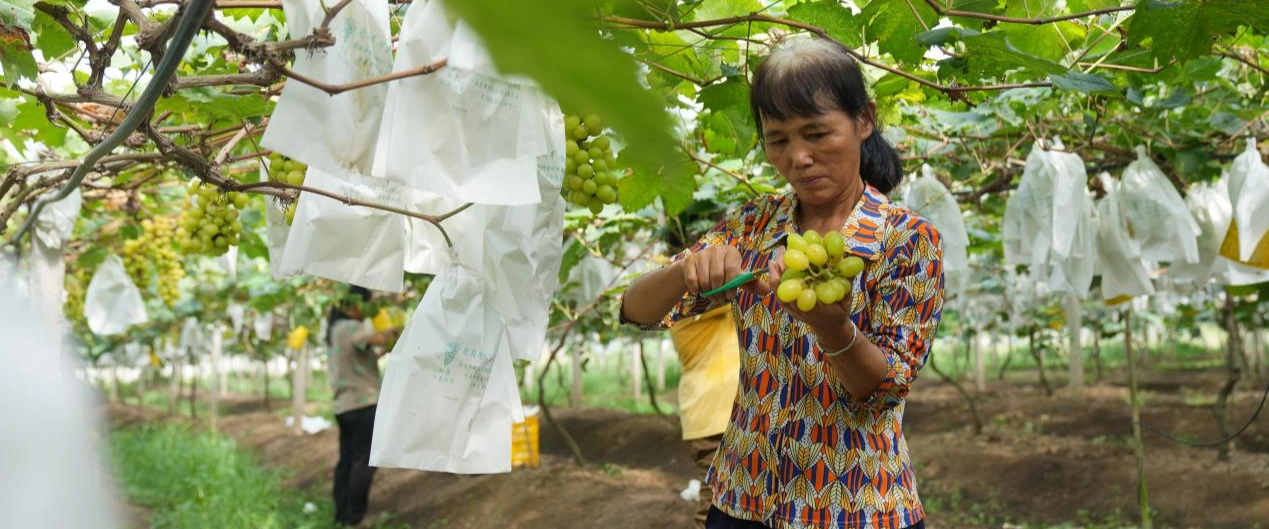Shine Muscat:”Hermès of the grape” is readily available to Chinese consumers.

This summer, the former aristocrat of fruits once again made its presence felt with a price drop, causing a sensation. When it first appeared on people’s radar, the “Shine Muscat” was priced at a high range of 300 to 400 yuan per bunch, which made people hesitate. Therefore, it earned the title of “Hermès of the grape.”
However, now the aristocrat has become a street vendor’s commodity. Not only has the price plummeted to ten yuan per kilogram, but consumer reviews have also declined. Some internet users have even given it a new nickname, “Dark Muscat,” because they find it unappetizing.
How did the Shine Muscat fall to this point? Are the affordable Shine Muscat grapes really not tasty?
The “Hermès of the grape,” two kilograms for ten yuan
If you ask someone who has eaten Shine Muscat grapes this year whether they are delicious or not, you may receive completely different answers. Some people think they are still as delicious as before, with a refreshing and sweet taste, while others feel they have been disappointed and the likelihood of disappointment is much higher than in previous years.
Although they still have a large size and are plump, many people criticize this year’s grapes for their particularly thick skins. The flesh can taste either excessively sweet, like drinking highly concentrated sugar water, making one’s throat feel blocked after eating a couple of them, or they have a sour and astringent taste. Moreover, the fragrance of roses is completely absent, making them no different from ordinary grapes.
However, everyone agrees on one thing: Shine Muscat grapes have indeed become much more affordable.
Now, it is very common to find Shine Muscat priced at 10 to 20 yuan per kilogram in fruit shops and supermarkets. You can even buy two to three kilograms for ten yuan at some roadside stalls, allowing people to enjoy them without any financial pressure, easily consuming a kilogram in a day.
You should know that Shine Muscat used to be priced as high as 50 yuan per grape. During festivals, receiving a bunch of Shine Muscat would be a huge surprise, and one would have to savor each grape. Taking a bite, the thin skin, thick flesh, abundant juice, and the delightful combination of sweetness and the fragrance of roses would make one feel like they were chilling in a rose paradise under the sunlight.
Shine Muscat didn’t suddenly become so affordable.
According to the price data disclosed by Beijing Xinfadi Agricultural Products Market, in the past three years, except for the first and second quarters of 2021, the average price of Shine Muscat in other seasons has been lower than the previous year.
In the second quarter of 2022, the average price of Shine Muscat reached as high as 33 yuan per kilogram, with the highest price soaring to 55 yuan per kilogram. However, this year, the highest price could only reach 43 yuan per kilogram, and the average price in the second quarter dropped to 28 yuan per kilogram.
Especially this year in October, the highest price was 16 yuan per kilogram, with an average price of 10.7 yuan per kilogram.
The reason why Shine Muscat has been highly noticeable in the past two to three months is twofold. First, their prices experience seasonal fluctuations. Starting in August, the market supply of Shine Muscat steadily increased, reaching its peak for the whole year, and as a result, the price continuously dropped, entering a low point.
Second, Shine Muscat grapes have become increasingly common in fruit shops. They are prominently displayed on the shelves, with a bright green color, making it easier for people to notice the significant price reduction.
Why has the price of Shine Muscat dropped so significantly in recent years?
The direct cause of the price drop is a substantial increase in production volume.
Shine Muscat grapes were introduced to China in 2006 when Professor Tao Jianmin from Nanjing Agricultural University brought them into the country through the “Introduction of International Advanced Agricultural Science and Accommodation Plan.”
In the following decade, although cultivation was introduced in various regions, the cultivation techniques were not up to par, and Shine Muscat failed to enter the public eye. In 2016, the domestic cultivation techniques for Shine Muscat finally matured, and domestically produced Shine Muscat reached their price peak, embarking on a path of rapid expansion.
For example, in Hunan’s largest Shine Muscat cultivation base in Li County, the planting area of Shine Muscat in 2021 was nearly 18 times that of 2016. The proportion of Shine Muscat in the total grape planting area in the county skyrocketed from 8.3% to 71.8%.
It’s not just Hunan. Due to the strong adaptability of Shine Muscat, they are now being planted all over the country.
According to the “2022 China Shine Muscat and Grape Industry Data Analysis Report” released by Yunguo, the planting area of Shine Muscat nationwide was 100,100 acres in 2016, which increased to 312,100 acres in 2021, showing a staggering growth rate of 211.79% over five years.
Many experts believe that the above data is still too conservative. Wang Haibo, an expert from the Fruit Tree Research Institute of the Chinese Academy of Sciences, once stated that according to incomplete statistics from the institute, the planting area of Shine Muscat reached 800,000 acres nationwide in 2020, and it is expected to exceed 1 million acres by 2022.
Grapes, which were originally best consumed from August to October, now have almost uninterrupted supply throughout the year.
From March to the end of April each year, the Shine Muscat grapes from the Yunnan River Valley are the first to hit the market. The unique geographical advantages of the Yunnan region allow plants to grow and develop with sufficient temperature and sunlight even in winter. By the end of May and early June, the Shine Muscat in Yunnan will be gradually harvested.
Starting from June, Shine Muscat grapes in the Guangdong and Guangxi regions begin to ripen and enter the market. After August, from south to north, regions such as Hunan, Sichuan, Chongqing, Jiangsu, Zhejiang, Shanghai, Henan, and Hebei will successively complete the harvest, ensuring a continuous supply of Shine Muscat until early November.
Due to the suitable climate in Yunnan and Guangxi, the “two harvests in one year” technique allows the second-season Shine Muscat to mature after New Year’s Day and before the Spring Festival.
Mass production and uninterrupted supply throughout the year have eventually made Shine Muscat readily available to consumers.
However, with mass production came a problem: Why does Shine Muscat seem less tasty now?
Currently, there is no unified quality standard for Shine Muscat in China. Different fruit merchants adjust their standards based on market demand and supply, resulting in a wide range of quality on the market. It is difficult to determine the tastiness of Shine Muscat solely based on its appearance.
To achieve first-class fruit quality, it is not an easy task. It requires meeting both the environmental and technological planting standards.
Rich organic matter and trace elements in the planting soil ensure the taste and fragrance of the grapes. Many fruit farmers use inorganic fertilizers such as phosphorus and potassium to save costs, which compromises the taste of Shine Muscat.
Controlling the production volume of Shine Muscat is also an important factor that affects the flavor. If excessive production is pursued to save costs and achieve larger fruit clusters, the resulting fruits lose their sweetness and the fragrant rose flavor.
Therefore, although Shine Muscat can be grown in many places, the differences in planting environments and the challenging cultivation requirements result in significant variations in quality among different regions.
As for why some consumers find Shine Muscat to be not sweet or even sour, in addition to the reasons mentioned above, it may also be because they bought immature fruits. To seize the market, many fruit farmers harvest the grapes prematurely. However, at this stage, the grapes are not fully ripe, lack sufficient sugar content, and have a bland flavor, and poor taste. On the other hand, if Shine Muscat grapes are not harvested in time after reaching maturity, as the hanging period lengthens, the sweetness of the fruits gradually increases, and when purchased, they may taste excessively sweet and cloying.
The decline of Shine Muscat brings both joy and concern to different people. Some are happy because the price has finally dropped, allowing ordinary people to enjoy this previously high-end fruit. However, the concern is that the taste of the cheaper version of Shine Muscat has been compromised.
Editor: Leo Cai


-300x169.webp)
